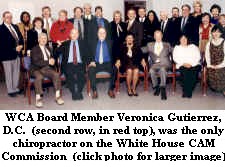|
|
|
April
2002
White House CAM Commission holds final meeting, issues
report
by Dr. Veronica Gutierrez, Commission members

The final
meeting of the White House Commission on Complementary and
Alternative Medicine Policy (WHCCAMP) was held Feb. 21-22 in
Washington, D.C., following 60 days of intensive conference calls
and e-mails between the staff and commission members in an attempt
to reach general agreement on the contents of the final
document.
When I was appointed to the Commission, I
had four personal goals to achieve for chiropractic:
1. Introduction and acceptance of the Association of Chiropractic
Colleges Paradigm on Chiropractic.
2. Clarification of terminology (e.g., spinal adjustment vs.
spinal manipulation; clinical necessity vs. medical necessity,
chiropractic vs. chiropractic medicine).
3. More research funding for models other than neck- and low-back
pain and the medical research model.
4. Student loan forgiveness for chiropractic students willing to
work in areas designated as MUAs/Medically Underserved areas.
The ACC paradigm was submitted early on in my participation. It
was reaffirmed and introduced again in December 2001 by Dr. Fabrizio
Mancini. The Commission accepted it.
Throughout the Commission document, all terminology referring to
chiropractic met my objectives.
The research recommendations are all inclusive of chiropractic
research in the areas of health and wellness, as well as quality of
life issues.
The big barrier was related to the student loan forgiveness. One
of the Commission members stated over and over again that Congress
had determined that chiropractors were not primary care providers
and, therefore, could not serve in the MUAs and receive loan
forgiveness. At first, I was unable to discovery what
"determination" this member was referring to.
Eventually, I uncovered the fact that two bills were submitted to
Congress-S. 1281 and S.1533. The former included chiropractors in
the National Health Service Corps/NHSC. However, the bill, as
written, states that: "(1) Chiropractic doctors are skilled at
providing a wide range of primary health care services, and (2)
Chiropractic doctors are often the only providers available to
provide health care in many rural areas.
The problem with this wording is that the Public Health Service
Act defines "primary care health services" as health services
involving "family medicine, internal medicine, pediatrics,
obstetrics and gynecology, dentistry, or mental health, that are
provided by physicians or other health professions."
Senate Bill 1533 was introduced by Sen. Kennedy and included
chiropractic. Section 317 of that bill authorized the establishment
of a demonstration project to provide for the participation of
doctors of chiropractic and pharmacists in the Loan Repayment
Program contained in section 338B of the bill. It is the intent of
the committee in approving this demonstration project that
participation be broad-based and comprehensive, and that the
Secretary ensure the scope of the demonstration project reaches to
all regions of the country.
My statements to the Commission have urged that chiropractors
engaged in "MUA" services should be allowed to be health care team
members as defined by the ACC Paradigm, with the practice of
chiropractic a unique and clearly different approach to health
promotion-disease prevention.
In my last communication with the Commission on this issue, I
stated, "From the first meeting, my position has been that
chiropractors deserve an opportunity to serve and prove that they
have a unique and desirable approach to healthcare. Chiropractic has
proven to be safe and effective and chiropractors are valuable
health care team members. It's not possible to accept that
individuals living in areas designated as MUAs are less deserving of
free choice in health care than others... If, at the end of a
demonstration project, chiropractic does not prove to be a service
of choice; is not proven to be safe and effective, or have any
value, then and only then do chiropractors not deserve to
participate nor the public receive the service."
This needs to be accomplished legislatively. I've stated before
the Commission that the Public Health Services Act was written when
the medical model was the politically dominant one. Congress has
become aware of the consumer movement's interest in non-allopathic
approaches and care, and Congressional intent appears now to be
responsive to meeting that need. A joint effort on the part of all
of the national associations and chiropractic colleges could very
easily define the practice of chiropractic for the 21st century.
I would like to publicly thank everyone who responded to my
request to testify before the Commission. Those who testified, and
their area of testimony, included:
*** Drs. Stuart & Theresa Warner, Chiropractic and
Children;
*** Dr. Christopher Kent, the Council on Chiropractic Practice
Guidelines and supporting research;
*** Dr. Patrick Gentempo, chiropractic philosophy and existing
outcomes assessment tools;
*** Dr. Donald Epstein, wellness;
*** Dr. John Adams, information and dissemination issues;
*** Drs. Charles and Marion Tedres-Masarsky, Somatovisceral
Aspects of Chiropractic, An Evidence-Based Approach;
*** Ron Hendrickson, ICA, background on chiropractic;
*** Dr. Robert Blanks, wellness research;
*** Dr. Brian McAulay, the need for college-based research
funding;
*** Dr. Jerry Hardee, the role chiropractors can play as
healthcare team members in MUAs;
*** Dr. Fabrizio Mancini, the chiropractic college curriculum and
training of chiropractors; and Dr. Ed Owens, chiropractic
research.
In addition, I wish to thank Ron Rupert of Palmer College for
gathering and listing all subluxation related research documents;
and the Chiropractic Leadership Alliance for taped interviews with
three cutting edge chiropractic researchers (Drs. Holder, Morter,
and Epstein).
Other individuals chiropractors and organizations offered oral
and written testimony, as well. Chiropractic definitely was
heard.
The complete WHCCAMP is available online at the Commission
website at http://whccamp.hhs.gov/finalreport.html.
(Dr. Veronica Gutierrez is a member of the Board of Directors of
the World Chiropractic Alliance and the only chiropractor appointed
to serve on the White House CAM Commission. She also chairs the WCA
Council on Women's Health and maintains a successful practice in the
state of
Washington.)
|
|